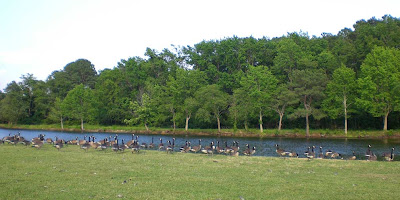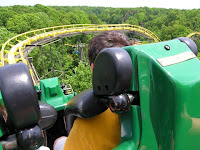 Frank took this picture on the pier that extends into the marsh at the Assateague Inn. We were out there looking at gulls and geese.
Frank took this picture on the pier that extends into the marsh at the Assateague Inn. We were out there looking at gulls and geese.I was wearing my new Chincoteague Island hat.
 Frank took this picture on the pier that extends into the marsh at the Assateague Inn. We were out there looking at gulls and geese.
Frank took this picture on the pier that extends into the marsh at the Assateague Inn. We were out there looking at gulls and geese. The place we stayed is named the Assateague Inn after the nearby island of Assateague. It's just off "Chicken City Road." There's a motel called the Chincoteague Inn not far away; we stayed there a few years ago. It was nice enough but I wanted a place with a kitchen.
The place we stayed is named the Assateague Inn after the nearby island of Assateague. It's just off "Chicken City Road." There's a motel called the Chincoteague Inn not far away; we stayed there a few years ago. It was nice enough but I wanted a place with a kitchen. Above is a rear view of the half of the inn which contains our unit. Below is part of the view from our sliding door. Note the large bird perched on the sign.
Above is a rear view of the half of the inn which contains our unit. Below is part of the view from our sliding door. Note the large bird perched on the sign.
 The wild horses of Assateague and Chincoteague have been famous since Misty of Chincoteague was published in 1947. This trio has gotten used to people and vehicles. They were in the parking lot next to the "wildlife loop" on Assateague Island.
The wild horses of Assateague and Chincoteague have been famous since Misty of Chincoteague was published in 1947. This trio has gotten used to people and vehicles. They were in the parking lot next to the "wildlife loop" on Assateague Island.
 On our first night on the Eastern Shore, we went to the Island House Restaurant in Wachapreague for dinner. We remembered it fondly from a prior visit and it did not disappoint. The food was good and the view is soothing.
On our first night on the Eastern Shore, we went to the Island House Restaurant in Wachapreague for dinner. We remembered it fondly from a prior visit and it did not disappoint. The food was good and the view is soothing.


Robert E. Lee, future Confederate General, was stationed at Fort Monroe 1831-1834 as a lieutenant of engineers. He had almost complete charge of construction and put the finishing touches on the fort. Lee's first child was born here in 1832.
 Here we see the cell where Jefferson Davis, President of the Confederacy, was held after the Civil War. He was suspected of being involved in the assassination of Lincoln but there was no evidence and eventually he was freed without being charged.
Here we see the cell where Jefferson Davis, President of the Confederacy, was held after the Civil War. He was suspected of being involved in the assassination of Lincoln but there was no evidence and eventually he was freed without being charged. The Casemate Museum has some surprising exhibits. This one depicts a life-size Edgar Allan Poe. It turns out that Poe was once stationed at Fort Monroe while in the military and later returned for a stay at the Hotel Hygeia. It’s said that the inspiration for “Annabel Lee” came from his time at Fort Monroe.
The Casemate Museum has some surprising exhibits. This one depicts a life-size Edgar Allan Poe. It turns out that Poe was once stationed at Fort Monroe while in the military and later returned for a stay at the Hotel Hygeia. It’s said that the inspiration for “Annabel Lee” came from his time at Fort Monroe. 
 Frank had never seen historic Fort Monroe and I remembered it from a field trip that I took over 15 years ago. We had talked about going there but would have skipped it as we headed for the Eastern Shore, except that traffic was slowed by an accident as we neared the Hampton Roads Tunnel.
Frank had never seen historic Fort Monroe and I remembered it from a field trip that I took over 15 years ago. We had talked about going there but would have skipped it as we headed for the Eastern Shore, except that traffic was slowed by an accident as we neared the Hampton Roads Tunnel. This Civil War Trails marker is near Fort Monroe at Phoebus, VA (now part of Hampton). It tells us that "Here stood the U.S. Army's first camp on Virginia soil after secession, built in May 1861. Only the Veteran's Cemetery on County Street remains of the entrenched camp."
This Civil War Trails marker is near Fort Monroe at Phoebus, VA (now part of Hampton). It tells us that "Here stood the U.S. Army's first camp on Virginia soil after secession, built in May 1861. Only the Veteran's Cemetery on County Street remains of the entrenched camp."
 Here we are in late afternoon at the amusement park. I was really dragging by that time, probably dehydrated. We had purchased an overpriced bottle of water earlier and refilled it from the tap several times, but we did not find any salty chips to buy. I had used up the cashews that I brought in my pocket and I really needed to consume something salty.
Here we are in late afternoon at the amusement park. I was really dragging by that time, probably dehydrated. We had purchased an overpriced bottle of water earlier and refilled it from the tap several times, but we did not find any salty chips to buy. I had used up the cashews that I brought in my pocket and I really needed to consume something salty. 
 We enjoyed the musical shows at Busch Gardens. These scenes are from a high-energy musical called American Jukebox.
We enjoyed the musical shows at Busch Gardens. These scenes are from a high-energy musical called American Jukebox.
 The Loch Ness Monster at Busch Gardens Williamsburg is celebrating her 30th anniversary. I was surprised to learn that because I remember when the monster was born... there were dramatic commercials telling you to experience it.
The Loch Ness Monster at Busch Gardens Williamsburg is celebrating her 30th anniversary. I was surprised to learn that because I remember when the monster was born... there were dramatic commercials telling you to experience it.
 These are a few pictures of our class at the monastery near Berryville. We were studying the Battle of Cool Spring (mentioned previously).
These are a few pictures of our class at the monastery near Berryville. We were studying the Battle of Cool Spring (mentioned previously).


 This is me at age 11. That was a long time ago.
This is me at age 11. That was a long time ago. We visited a garden pond dealer who had two pretty collies. One of them had an unfortunate habit of carrying off the water plants that were for sale, though.
We visited a garden pond dealer who had two pretty collies. One of them had an unfortunate habit of carrying off the water plants that were for sale, though. At Snickers Gap a major road (now Route 7) crosses the Blue Ridge in Virginia. In the picture we're on the old winding road up the hill from Bluemont. We were there tracing Jubal Early's retreat from Maryland in July 1864. He had managed to cause distress in Washington D.C. by attacking Fort Stevens, but had been forced to retreat. Also his army had failed to reach Point Lookout, where Confederate prisoner's were held.
At Snickers Gap a major road (now Route 7) crosses the Blue Ridge in Virginia. In the picture we're on the old winding road up the hill from Bluemont. We were there tracing Jubal Early's retreat from Maryland in July 1864. He had managed to cause distress in Washington D.C. by attacking Fort Stevens, but had been forced to retreat. Also his army had failed to reach Point Lookout, where Confederate prisoner's were held.
 Here's a photograph from 1958. It shows my dad and my younger sister at Mary's Rock, Shenandoah National Park.
Here's a photograph from 1958. It shows my dad and my younger sister at Mary's Rock, Shenandoah National Park.

 | |
 | The farm owned by the Best family was also part of the 1862 Maryland Campaign. Lee's "lost order No. 191" was found on this farm by Union soldiers. The Worthington Farm (left) has a trail to the Monocacy River where Confederate troops crossed in 1964. They set up artillery in the front yard, and every time the gun fired, the farmyard rooster would crow. The Worthington family took shelter in the cellar during the battle. (For close-up and text of Worthington marker, click here.) |
 Read the markers "Thick of Battle" and "Thomas Farm". Not shown here is another nearby marker called "Federal Retreat."
Read the markers "Thick of Battle" and "Thomas Farm". Not shown here is another nearby marker called "Federal Retreat."Daily Photo

Navigating this Blog: You can search the 9,200+ entries in this blog using the Search box at the top left of the page. To view other recent posts, use the Older Posts link (above right) or scroll up to the Blog archive and click on this month or last month in the sidebar on the left. Also check out the labels (tags) to see posts about one of my frequent topics (such as Shenandoah or Family or Birds.
Thanks for Visiting!